
Dili is the capital and largest city of East Timor. It lies on the northern coast of the island of Timor, in a small area of flat land hemmed in by mountains. The climate is tropical, with distinct wet and dry seasons. The city has served as the economic hub and chief port of what is now East Timor since its designation as the capital of Portuguese Timor in 1769. It also serves as the capital of the Dili Municipality, which includes some rural subdivisions in addition to the urban ones that make up the city itself. Dili's growing population is relatively youthful, being mostly of working age. The local language is Tetum; however, residents include many internal migrants from other areas of the country.

The political system in Timor-Leste is a unitary semi-presidential representative democratic republic, whereby the Prime Minister of Timor-Leste is the head of government and the President of Timor-Leste functions as head of state. Timor-Leste has a multi-party system. Executive power is exercised by the president and the government. Legislative power is vested in both the government and the National Parliament. The Judiciary is independent of the executive and the legislature. The East Timorese constitution was modelled on that of Portugal, with lesser power given to the president. The country is still in the process of building its administration and governmental institutions. The Economist Intelligence Unit rated East Timor a "flawed democracy" in 2022.

East Timor is divided into 14 municipalities, which are former districts. One municipality is also a Special Administrative Region (SAR). The municipalities are divided into administrative posts, and further subdivided into sucos (villages). Atauro Island was initially a part of Dili Municipality, but became a separate municipality on 1 January 2022. The borders between Cova Lima and Ainaro and between Baucau and Viqueque were changed in 2003.

Baucau is a municipality, and was formerly a district, of East Timor, on the northern coast in the eastern part of the country. The capital is also called Baucau. The population of the municipality is 111,694 and it has an area of 1,506 km2.
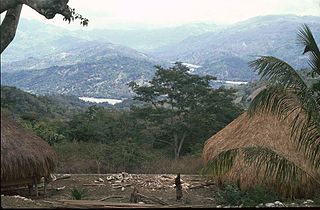
Bobonaro is a municipality in the Democratic Republic of Timor-Leste commonly known as East Timor. It is the second-most western municipality on the east half of the island. It has a population of 92,045 and an area of 1,376 km2.

East Timor was a province of Indonesia between 1976 and 1999, during the Indonesian occupation of the country. Its territory corresponded to the previous Portuguese Timor and to the present-day independent country of East Timor.

Manatuto is one of the municipalities of East Timor, located in the central part of the country. It has a population of 45,541 and an area of 1,783.3 km2. The capital of the municipality is also named Manatuto. It is the least populated municipality of East Timor.

Baucau is the second-largest city in East Timor, after Dili, the capital, which lies 122 km (76 mi) to its west.
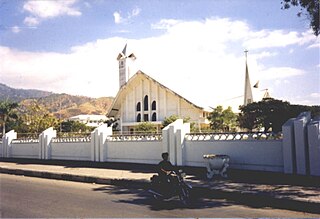
Dili Municipality is one of the 14 municipalities, formerly districts, of Timor-Leste, and includes the national capital Dili. The municipality had a population of 277,279 as of 2015, most of whom live in the capital city.

Baguia, officially Baguia Administrative Post, is an administrative post in Baucau municipality, East Timor. Its seat or administrative centre is Alawa Leten, and it has ten sucos.
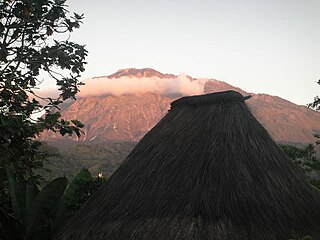
Quelicai, officially Quelicai Administrative Post, is an administrative post in Baucau municipality, East Timor. Its seat or administrative centre is Lacoliu.
Venilale is a town located about 30 km south of Baucau in East Timor. It is the capital of the Venilale Administrative Post.
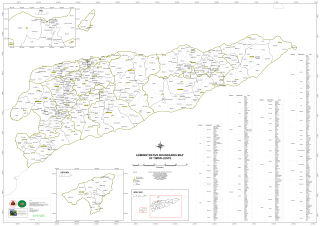
The administrative posts of East Timor are subdivided into 442 sucos ("villages") and 2,336 aldeias ("communities"). Sucos have been part of the country's administrative system since the 20th century, under Portuguese, Japanese, Indonesian, and independent rule.
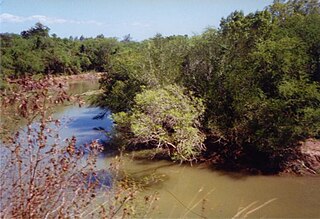
The Seiçal River is a major river in northeastern Timor-Leste. It flows for the most part in a northerly direction from headwaters in Timor's central mountains; after running past the eastern edge of the Baucau Plateau, it discharges into Wetar Strait.

The Roman Catholic Diocese of Maliana is a Latin Church diocese of the Catholic Church in East Timor. The newest of the country's three dioceses, it was established in 2010 by Pope Benedict XVI. It serves nearly 300,000 Catholics in the municipalities of Bobonaro, Cova Lima, and Liquiçá, covering a total area of 3,142 km2. The current bishop since the diocese's founding is Norberto do Amaral.
Taça Digicel was a football championship organized by the East Timor Football Federation. It was replaced by Taça 12 de Novembro in 2013.

Venilale, officially Venilale Administrative Post, is an administrative post in Baucau municipality, East Timor. Its seat or administrative centre is Uatu Haco.

The Laleia River is a major river in northeastern Timor-Leste. It flows north from the country's central mountains into Wetar Strait.

















